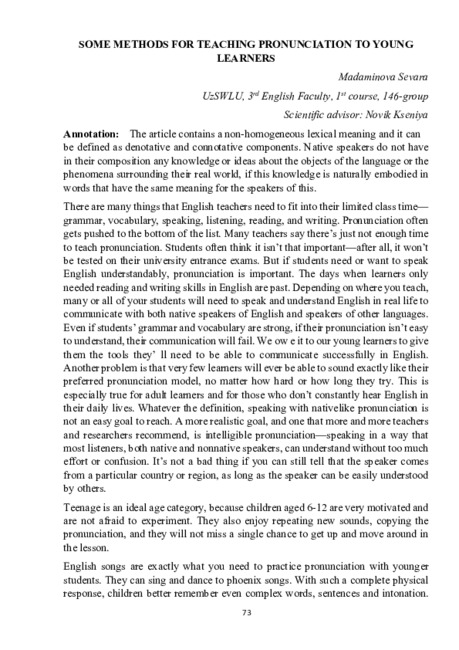
73
SOME METHODS FOR TEACHING PRONUNCIATION TO YOUNG
LEARNERS
Madaminova Sevara
UzSWLU, 3
rd
English Faculty, 1
st
course, 146-group
Scientific advisor: Novik Kseniya
Annotation:
The article contains a non-homogeneous lexical meaning and it can
be defined as denotative and connotative components. Native speakers do not have
in their composition any knowledge or ideas about the objects of the language or the
phenomena surrounding their real world, if this knowledge is naturally embodied in
words that have the same meaning for the speakers of this.
There are many things that English teachers need to fit into their limited class time—
grammar, vocabulary, speaking, listening, reading, and writing. Pronunciation often
gets pushed to the bottom of the list. Many teachers say there’s just not enough time
to teach pronunciation. Students often think it isn’t that important—after all, it won’t
be tested on their university entrance exams. But if students need or want to speak
English understandably, pronunciation is important. The days when learners only
needed reading and writing skills in English are past. Depending on where you teach,
many or all of your students will need to speak and understand English in real life to
communicate with both native speakers of English and speakers of other languages.
Even if students’ grammar and vocabulary are strong, if their pronunciation isn’t easy
to understand, their communication will fail. We ow e it to our young learners to give
them the tools they’ ll need to be able to communicate successfully in English.
Another problem is that very few learners will ever be able to sound exactly like their
preferred pronunciation model, no matter how hard or how long they try. This is
especially true for adult learners and for those who don’t constantly hear English in
their daily lives. Whatever the definition, speaking with nativelike pronunciation is
not an easy goal to reach. A more realistic goal, and one that more and more teachers
and researchers recommend, is intelligible pronunciation—speaking in a way that
most listeners, both native and nonnative speakers, can understand without too much
effort or confusion. It’s not a bad thing if you can still tell that the speaker comes
from a particular country or region, as long as the speaker can be easily understood
by others.
Teenage is an ideal age category, because children aged 6-12 are very motivated and
are not afraid to experiment. They also enjoy repeating new sounds, copying the
pronunciation, and they will not miss a single chance to get up and move around in
the lesson.
English songs are exactly what you need to practice pronunciation with younger
students. They can sing and dance to phoenix songs. With such a complete physical
response, children better remember even complex words, sentences and intonation.

74
At first glance, singing songs is a very simple activity, but it is useful. Here, for
example, are wonderful collections of songs with phonics.
Rhyming is another activity that focuses on making children learn to distinguish
between phonemes. Therefore, activities should also focus on how the words sound.
For such tasks, both cards with images and printed words are suitable.
Pronunciation Maze: This game makes students both teenagers and adults solve a
logic puzzle in order to complete a pronunciation task. In the diagonal box, write a
line of words with a common sound, such as the same vowel, between the top left
corner and the bottom right corner. In all other boxes, write words that people think
have the same sound but don't. Students must get from the starting point to the end
along the correct route. After they are done, with the students, use drilling to say the
words on the correct route, and then all the surrounding words with different sounds.
For example : Gave, white, have, wave, states, site, plane, plan, wait, water,
main, plain, place, pays, might, weigh, night, hate, why, when, rain, way, hat,
wash,late.
Tongue twisters can help to develop English speech as well. Look at these examples
and follow the pronunciation and intonation.
She sells sea shells on the sea shore
A proper copper coffee pot
Around the rugged rocks the ragged rascal ran
Red lorry, yellow lorry, red lorry, yellow lorry
A big black bug bit a big black bear
There might be differences in placement of word stress, quality and intensity of
syllables, speech rhythm, intonation, etc. It is quite common to assimilate English
sounds to the mother tongue sounds and to apply other suprasegmental features of
the native language to pronunciation of English. However, in teaching English
pronunciation, such assimilation should be avoided and learners need to be taught
correct segmental and suprasegmental features of pronunciation.
References:
1)
Lenneberg E. H. (1967). The Biological Foundations of Language (New York:
Wiley).
2)
Schmidt RW (1990). The role of consciousness in learning a second language.
Applied Linguistics 11 129-158.
3)
Bongarts T, Planken B, Shiels E and Van Summeren s (1997). Age and limitation
of achievements in the pronunciation of a foreign language. CPR, 19 447-465.

75
4)
Ann Baker (Ship or Sheep?) An Intermediate Pronunciation Course. Published:
Cambridge University Press, 2006.
5)
Paluanova, X. D. "Derivation-semantic principles of ecological terms in English,
Uzbek, Russian and Karakalpak languages: Dr. phil. sci. diss." (2016).
6)
Paluanova, H. "Reading comprehension and its development in teaching foreign
languages." Психология и педагогика: методика и проблемы практического
применения 50-2 (2016): 67-71.






